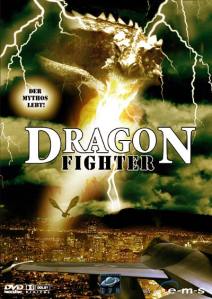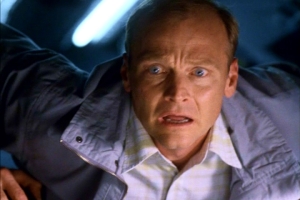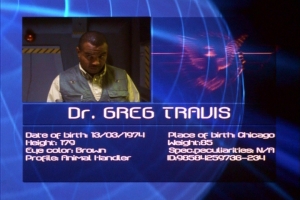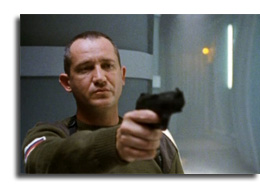Dragon Fighter – “It came from the past, to destroy the future”
Who doesn’t love dragons? They can be good guys; bad guys; pets; and they’re basically the sharks of the air. Sharks who breathe fire. And have legs. With claws. But I digress. The point is, dragons are awesome. This movie, on the other hand…
Dragon Fighter is not at all what you’d expect, most likely. Capt. David Carver (Dean Cain, Maneater; Lois & Clark: The New Adventures of Superman) is assigned as head of security for a top-secret research lab in southern California. The team, led by Dr. Ian Drackovitch (Robert Zachar, Python 2; Star Trek: First Contact), includes Dr. Meredith Winter (Kristine Byers, Dragon Fighter; Spring Break Lawyer) and various expendables, all tasked with returning species from extinction when that extinction was caused by humans. The “good” Dr. Drackovitch brings a new specimen to the lab, claiming it is the remains of what appears to be a dinosaur relative, remains which are dated only back to 12th Century England instead of the extinction event that killed all the rest (estimated to have occurred about 65 million years ago). Naturally, he insists that his team clone and hatch the find, despite David’s suggestion that it could, in fact, be a dragon. It does, in fact, turn out to be a dragon, which then does, in fact, go on a rampage throughout the facility, causing all manner of dragony mayhem.
Top left – Capt. David Carver; top right – Dr. Ian Drackovitch; middle left – Dr. Meredith Winter; middle right – dragony mayhem, not to be confused with Mr. Mayhem (bottom)
So what did this movie have? Well, it had better than average CGI for most of it (there’s some pretty awful stuff at the beginning, but the rest is decent), but worse than average acting (“average”, here, referring to the SyFy standard). The writing was passable, but definitely seemed to jump around in places, an issue accentuated by often-stilted line delivery. But the music was good, overall. Also, much of the movie was shot in a way reminiscent of Alien, which to my mind is always a good thing. The strangest artistic choices, however, were the copious use of split screens and the scene transitions that were made to look like security camera footage. Both of these were used extensively throughout the movie, and while there were occasional moments where one scene transitioned to another through a camera feed someone was watching, more often than not they made no sense and detracted from the flow of the movie. There were also computer dossiers that came up when certain characters were introduced, again being completely unnecessary, and kind of jarring to see, as they didn’t fit in with any of the action before or after.
Early dragon…
…and later dragon…
…and I swear, it was almost an hour and half of this…
…and this
This one also had clichés, as expected, the most obvious two being the I’m-a-scientist-so-your-thoughts-don’t-matter cliché, and the I’m-gonna-be-famous-consequences-be-damned cliché. As you might have guessed, both of these were embodied in Dr. Drackovitch, who spends the better part of the first half of the movie sneering at David and deriding him every chance he gets, and the better part of the second half of the movie sabotaging every effort to escape or kill the dragon. Interestingly, although Ian insults David’s intelligence and assumed lack of education or scientific insight, he ends up sharing David’s suspicion that the sample he brought is indeed a dragon, and it is later revealed that Ian spent an unknown but presumably lengthy portion of his life looking for proof of the existence of dragons. And while it isn’t explored at any length in this movie, the debate between making history and moral responsibility is briefly brought up, heavily biased towards the moral responsibility of prevent the escape of the dragon into the world. On a side note, much though I appreciate the sentiment of debates of this nature, part of me wishes that these movies would realize that their audience is not watching them for academic philosophical challenges to their worldview; we’re watching these movie because they have dragons (or Mongolian death worms, or homicidal ghosts, or enterprising aliens, or…). Not every movie that gets made needs to have a deep and profound meaning and impact on the world; in fact, most of them don’t. Take pride in what you are, B horror movies, and leave it at that.
“In Mother Russia, movie critique YOU!”
Most importantly, what this movie had was science, and not just any science, but my own personal favorite branch of science, genetics (via cloning, in this case).
We all remember back when it was this big thing that they found this mosquito fossilized in amber, and pretty soon there were dinosaurs everywhere thanks to cloning. Right? I mean, that did actually happen, didn’t it? Yeah, I’m pretty sure it did. Anyway, this movie is kinda like that, only much less awesome. Like I mentioned above, Dr. Drackovitch brings a dragon egg to the lab, from which two intact cells are recovered and combined to make a dragon zygote, which then divides and becomes what appears to be a full-grown dragon within a matter of hours. In the most basic of senses, this actually is what happens during the cloning process – the nucleus of one cell is removed and inserted into another cell, then the new combination is stimulated to divide.
“Damn it feels good to be a scientist!”
However. (There’s always one of these in here, isn’t there…)
“Not if I crush all dissent!”
After an organism dies, its body immediately begins to be broken down by various bacteria, insects, or other scavengers. More significantly for the movie, DNA begins to degrade through natural cellular processes (see here or here for broader studies, or here for an in-depth look at the chemistry of DNA degradation). What this means is that finding any DNA can be a tricky thing when looking at specimens past a certain age (though to be fair, not too long ago, DNA was extracted from bird eggs up to 19,000 years old). But here’s the key – for the cloning process to work, the donor nucleus (or, in this case, nuclei) needs to be complete; some limited amount of damage to the DNA might be overcome, but large-scale degradation would absolutely pose a problem. And while the entire genome of an organism can be deduced by examining DNA fragments from many sources, the movie scientists manage to find two completely intact nuclei and fuse them together. I’m not great at statistics, but I’m pretty comfortable saying that this is pretty much impossible to do in a specimen that’s 1000 years old, especially considering that the movie specifically says that the DNA from each cell is undamaged and intact.
“Who’s a good cloned puppy? WHO’S a good cloned puppy? You are! Yes you are!”
Since I’m a genetics nerd, I’m going to digress for a moment and discuss somatic-cell nuclear transfer (cloning) in more detail as it relates to the movie. “Cloning”, in the colloquial sense, involves taking the nucleus out of an egg cell and discarding it, and then inserting the diploid nucleus of a second cell into the “empty” egg cell (I should point out that, while vertebrates are predominantly diploid, there are a number of species known to be polyploid, including some reptiles). For the sake of discussion, I am assuming that dragons are diploid animals. What this means, then, is that combining two somatic nuclei in one cell and then causing the cell to divide would most likely either create two new somatic cells from the original tetraploid cell, or result in a permanently tetraploid animal. This latter situation would most likely be fatal (though it’s certainly not guaranteed to be so), and the former situation would, at best, probably lead to a growth of a specific dragon cell type. Either way, the method shown in the movie would all but definitely not lead to a viable, fully differentiated baby dragon.
Who’s an impossible genetic freak? WHO’S an impossible genetic freak? You are! Yes you are!
But however they did it, they created a dragon. Which turned out to want to nest under air conditioner vents, because apparently it was warm-blooded, and that’s what warm-blooded things do, I guess. But reptiles are cold-blooded, you say. Everyone knows that, you say. Right?, you say. Wrong. For a start, there’s the leatherback sea turtle, which has been shown to be endothermic. Then there’s the dinosaurs. Recent research shows that Harris lines, the classically accepted indicators of cold-bloodedness in dinosaurs, are also found in mammals, rendering them essentially useless in demonstrating ectothermy. This is not to say that dinosaurs were warm-blooded, of course; just that there is now less evidence to suggest that they were cold-blooded. How’s that for upsetting your worldview?
“Sergei doesn’t like it! Is lie, and Sergei doesn’t like lies!”
So that about does it for Dragon Fighter. Until next time, keep an eye to the skies; who knows where the sharks will end up next?
Posted on July 27, 2012, in B-movies, Movies, SyFy Channel and tagged creature movie, dragon, jumping the shark, Sci Fi Channel, SyFy, SyFy Channel. Bookmark the permalink. 6 Comments.


























The split screens look similar to those used in Ang Lee’s HULK. I’d accuse this movie of ripping it off, but DRAGON FIGHTER was released about six months earlier. I guess this is a case of a Syfy original movie actually attempting something artistic (it didn’t work especially well in HULK, either).
One thing I found really amusing was when I looked up the director on imdb. He’s got quite the filmography of movies I’ve never heard of and will probably never see. I’d be interested in seeing you examine which directors have popped up multiple times in the blog, and if there’s anything that distinguishes one from another.
I’ve actually already noticed a number of director names show up multiple times in movies I’ve either already reviewed or will review, the most memorable one (to me) being Tibor Takacs. I’ve also noticed that they do a lot of filming for a lot of their movies in Bulgaria, I think because they have a studio or partnership with a studio there. But I have to say, recognizing directorial styles might be somewhat beyond me. Maybe after I’ve watched a lot of movies and start to get a more nuanced feel for this whole “critique” thing.
Really all you have to do is look at the movies you’ve seen by a particular director and see if there’s any recurring stuff (images, ideas, etc.). These guys are far from auteurs, so there’s a good chance there won’t be anything. Still curious, though.
Well, the obvious one is Uwe Boll, who typically includes images from whatever video game he’s adapting, but I’ll keep an eye out for others. For me right now, though, what’s more interesting is looking at first of all how many moderately successful actors end up in these movies, and second, how many of them share connections via past projects. Because I’ll tell ya, the same people keep coming up, as do the same shows and movies. It’s definitely kind of strange.
Really, aside from learning some turtles might not be cold-blooded, all I have gathered from this movie review is that 1) it’s a terrible movie and 2), Superman is from Wisconsin.
Also, why aren’t there any units for their height and weight? Terrible.
I think we all already knew that Superman came from Wisconsin. I mean, really. It just makes sense. Any the unit thing drove me pretty crazy, being a scientist and all. It made the info screens that much more pointless.